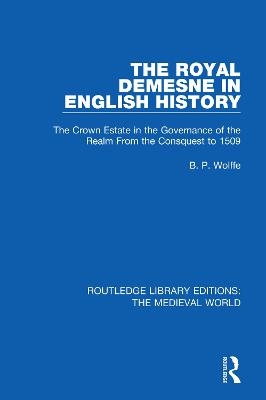
The Royal Demesne in English History
Routledge (Verlag)
978-0-367-20859-2 (ISBN)
Originally published in 1971, The Royal Demesne in English History shows how Norman and Angevin kings were able to regard the whole of their English kingdom as their royal demesne in the continental medieval sense. The book argues that only through the later loss of their continental possessions were they compelled to show interest in creating special royal estates within their English kingdom, and then only for the members of their families. The power of medieval English kings as landowners provides a constant theme of the highest political importance in the dispensation of royal patronage, but not in the history of government finance. The book discusses how in the later stages of the cumulative creation of the royal family estates, did the idea gain currency in England, that an endowed and inalienable royal landed estate ought to form the basis of monarchical stability and financial solvency. This book forms an interesting and detailed look at the development of the medieval monarchy in terms of land and ownership.
Preface Abbreviations Part I: The Royal Demesne in Norman and Angevin Government 1. Royal Demesne and Tallage 2. ‘Ancient Demesne’ 3. Royal Demesne and Parliamentary Taxation 4. Royal Demesne and Land Revenue 5. Royal Demesne and Patronage 6. Contrasts in the Role of the Capetian Domaine 7. Restraints of Alienation in England and the Genesis of ‘the King to Live of his Own’ Part II: A New Royal Patrimony: The Plantagenet Family Estate 1227-1399 8. Family Endowments 9. Alienations Outside the Royal Family 10. Finance and Royal Patronage 11. Exchequer and Chamber Administration 12. Parliamentary Criticism Part III: Patronage, Politics and Finance, 1399-1437 13. Parliament and the Act of Resumption 1404 14. The Financial Survey of 1433 Part IV: The Background to the Resumptions of 1450-6 15. The Royal Lands and the Spoils System Under Henry VI 16. Resumption as the Panacea for Financial Reform 17. The Collapse of Royal Government, 1437-50 Part V: The Resumptions of 1450-6 18. The Leicester Act of Resumption of May 1450 19. The Act of Resumption of March 1451 20. The ‘Yorkist’ Act of Resumption of 1455-6 21. The Significance of the Resumptions Part VI: The Crown Estate of the Yorkist Kings 22. Edward IV’S Act of Resumption 23. Receiver’s, Surveyors and Auditors of Land Revenues, 1461-83 24. Administrative Changes in the Central Government Under Edward IV 25. Richard III and the Crown Lands Part VII: Henry VII’s Land Revenues and Chamber Finance 26. The Collapse and Re-Establishment of the Yorkist Land Revenue 27. Lancastrian, Yorkist and Early Tudor Lands Revenues Compared Part VIII: Conclusion Appendix A: Lands of the Royal Family, 1327-77 Appendix B: The Proposed Confiscation of Temporalities of the Church in 1404 Appendix C: The Crown Lands as Affected by the Acts of Resumption 1450-61 Appendix D: The Management of the Crown Lands, 1461-85. Lists of Officers with the Area if Their Charge Index
| Erscheinungsdatum | 15.01.2021 |
|---|---|
| Reihe/Serie | Routledge Library Editions: The Medieval World |
| Verlagsort | London |
| Sprache | englisch |
| Maße | 156 x 234 mm |
| Gewicht | 598 g |
| Themenwelt | Geschichte ► Allgemeine Geschichte ► Mittelalter |
| Geschichte ► Allgemeine Geschichte ► Neuzeit (bis 1918) | |
| Geisteswissenschaften ► Geschichte ► Regional- / Ländergeschichte | |
| ISBN-10 | 0-367-20859-8 / 0367208598 |
| ISBN-13 | 978-0-367-20859-2 / 9780367208592 |
| Zustand | Neuware |
| Informationen gemäß Produktsicherheitsverordnung (GPSR) | |
| Haben Sie eine Frage zum Produkt? |
aus dem Bereich


